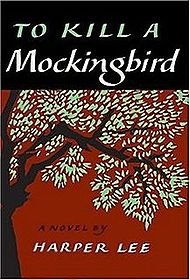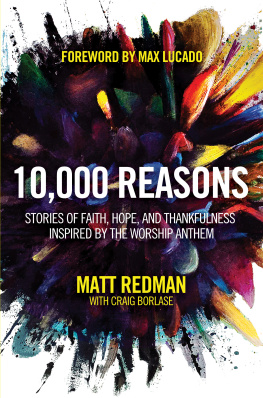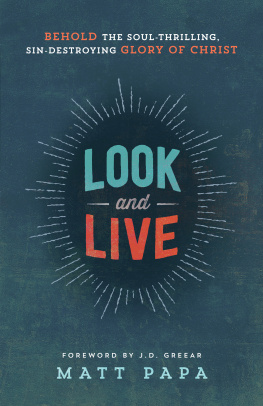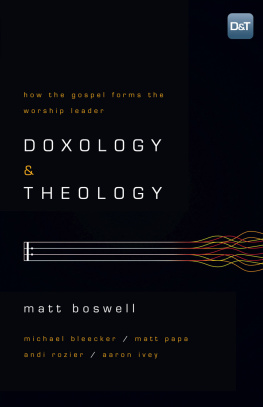THE FAITH OF A MOCKINGBIRD
MATT RAWLE
The Faith of a

Mockingbird
A SMALL GROUP STUDY CONNECTING CHRIST AND CULTURE

THE FAITH OF A MOCKINGBIRD
A SMALL GROUP STUDY
CONNECTING CHRIST AND CULTURE
Copyright 2015 by Abingdon Press
All rights reserved.
No part of this work may be reproduced or transmitted in any form or by any means, electronic or mechanical, including photocopying and recording, or by any information storage or retrieval system, except as may be expressly permitted by the 1976 Copyright Act or in writing from the publisher. Requests for permission can be addressed to Permissions, The United Methodist Publishing House, 2222 Rosa L. Parks Blvd, PO Box 280988, Nashville, TN 37228-0988; or e-mailed to .
This book is printed on elemental, chlorine-free paper.
ISBN 978-1-5018-0369-7
Scripture quotations, unless noted otherwise, are from the Common English Bible. Copyright 2011 by the Common English Bible. All rights reserved. Used by permission. www.CommonEnglishBible.com .
Scripture quotations marked HCSB are taken from the HOLMAN CHRISTIAN STANDARD BIBLE. 1999, 2000, 2002, 2003 by Broadman and Holman Publishers. All rights reserved.
Scripture quotations marked NASB are taken from the NEW AMERICAN STANDARD BIBLE. The Lockman Foundation 1960, 1962, 1963, 1968, 1971, 1972, 1973, 1975, 1977. Used by permission.
Scripture quotations marked NRSV are taken from the New Revised Standard Version of the Bible, copyright 1989, Division of Christian Education of the National Council of the Churches of Christ in the United States of America. Used by permission. All rights reserved.
15 16 17 18 19 20 21 22 23 2410 9 8 7 6 5 4 3 2 1
MANUFACTURED IN THE UNITED STATES OF AMERICA
For my wife, Christie
CONTENTS
The Faith of a Mockingbird
INTRODUCTION
What comes to mind when you hear someone refer to pop culture?
Maybe you think about fast food restaurants or the newest phone apps or the reality televisionall things that are seemingly ever-present in our world today. Or maybe your mind tends to drift back to what was most popular when you were a kid. Maybe visions of bell bottoms and disco, or big hair and neon spandex, or flannel shirts and grunge rock dance through your mind.
No matter which decade you were born in, there is no doubt that the popular culture of the timethe music, the books, the television, the movies, the media has much to say about the world in which we live. The word culture is used often, by many different people in many different ways, but in its simplest form, culture is simply an expression of how a community understands itself. God, our Creator, supplies us with the raw ingredients of humanitytalents, time, creativity, desires, ingenuityand culture is whatever we cook up. Stories, songs, recipes, traditions, art, and language are all displays of how we interpret the world and our place in it.
So what role does God play in our culturein our day-to-day lives and in the work of our hands that produces music and art and literature and plays and movies and technology? Throughout history, people have debated this issue and adamantly drawn a dividing line between that which should be considered sacred (that which is explicitly religious in nature) and that which should be considered secular (that is, everything else). At first glance, these may be seemingly easy judgments to make, but when we stop to examine what God has to say about this division, we might be surprised at what we find.
Scripture says that all things were made through Christ (John 1:3), and through Christ all things were reconciled to God (Colossians 1:20). In other words, everything and everyone in our world contains a spark of the divineeverything is sacred, and whether or not we choose to live in that truth depends on our perspective. For example, think of sunlight as a holy (sacred) gift from God. God offers us sunlight so that we can see the world around us. We can celebrate the sacred by creating things that enhance the light in our homes, such as larger windows or skylights, or we can hang heavy drapes and close the shutters in order to diminish the sacred and shut out the light. Our sacred work is letting in as much light as possible, and those things that keep the light out need to be rejected or transformed.
Through Jesus, God put on flesh and walked among us, in order to re-narrate what it means to be a child of God. God assumed culture and transformed it. So now all is sacred, and in everything we are to see and proclaim his glory. I truly believe we are called not to reject the culture we live in, but to re-narrate its meaningto tell Gods story in the midst of it. Jesus didnt reject the Cross (the sin of our world); rather, Jesus accepted it and transformed it from a death instrument into a symbol of life and reconciliation.
THE POP IN CULTURE
Sometimes its easy to see God in the midst of culturein the stories of Scripture and in reverent hymns and worshipful icons. Other times the divine is more veiledhidden in a novel, concealed in classic rock, obscured by an impressionists palate.
As we walk with Christ, we discover the divine all around us, and in turn, the world invites us into a deeper picture of its Creator. Through this lens of Gods redemption story, we are invited to look at culture in a new and inviting way. We are invited to dive into the realms of literature, art, and entertainment to explore and discover how God is working in and through us and in the world around us to tell his great story of redemption.
The Pop in Culture series is a collection of studies about faith and popular culture. Each study uses a work of pop culture as a way to examine questions and issues of the Christian faith. Studies consist of a book, DVD, and leader guide. Our hope and prayer is that the studies will open our eyes to the spiritual truths that exist all around us in books, movies, music, and television.
TO KILL A MOCKINGBIRD
Sin and redemption and wisdom and love are all themes that comprise Harper Lees masterpiece, To Kill a Mockingbird. An influential and transformative work, To Kill a Mockingbird is one piece of popular culture that has certainly withstood the test of time. Published in 1960, To Kill a Mockingbird serves as a lens through which we can understand our place in the world, how we play a role in Gods story, and what it means to live out a hopeful faith in a broken world.
In this study, we will explore the attributes and lives of four of the books main charactersScout Finch, Atticus Finch, Tom Robinson, and Boo Radleyand what each can teach us about faith and redemption. Each chapter is divided into five sections, perfect for daily readings, with questions for reflection at the end of each section. We begin with Scout, our narrator, who offers her story as a means of understanding our own. Next we will look at the fascinating character of Atticus Finch, who culturally redefines what it means to be a heronamely that Christians arent called to be heroes, but saints. Then we encounter Tom Robinson, who begs us to ask how we can fight the good fight of racial reconciliation. Finally, we will ponder one of the most haunting questions in all of American literatureWho is Boo Radley?and explore how Scouts fascination with Boo can drive our desire to discover our sometimes mysterious Lord.
Next page







